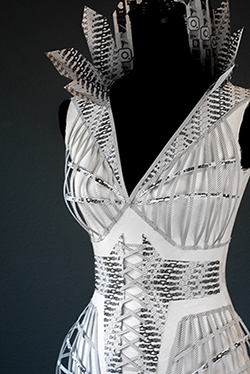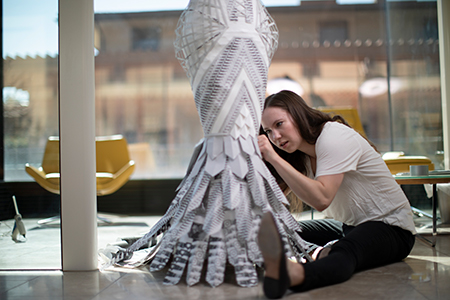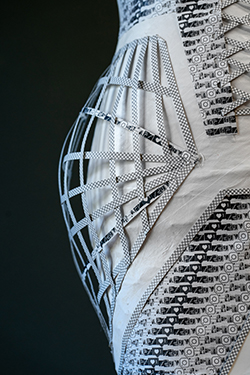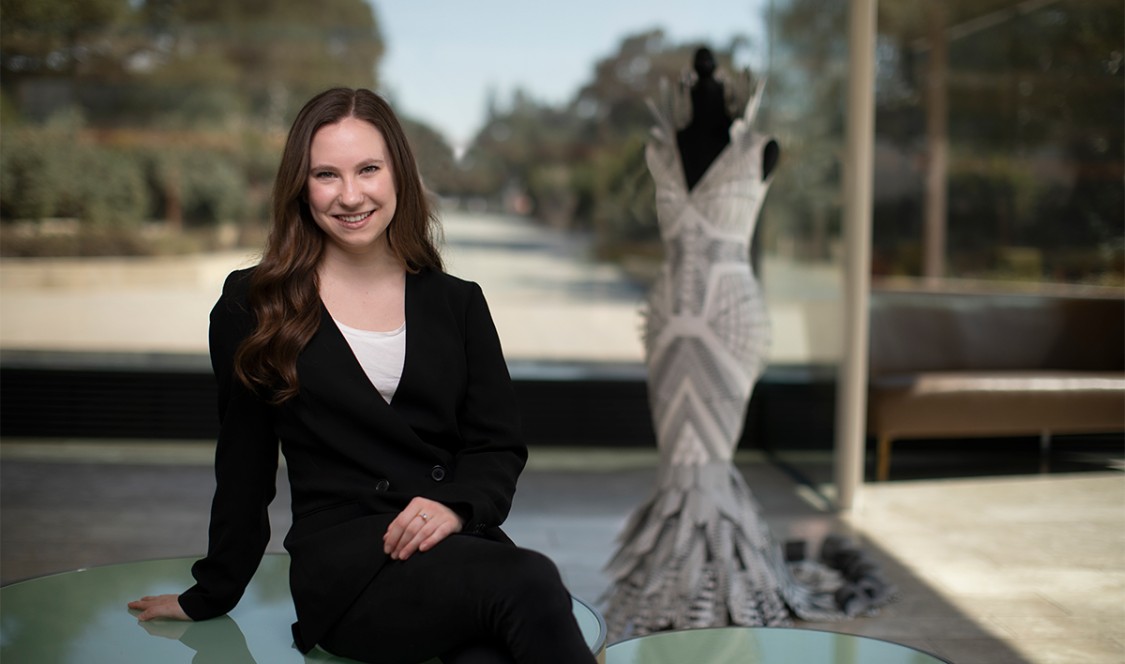For someone who doesn’t spend a lot of time on social media, Tori Johnson ’21 sure knew how to make a bold, visual statement about it.

Photo by Tori Johnson
As part of her summer Creative Works Fellowship through the Gould Center for Humanistic Studies, Johnson created a papier-mache dress that serves as a mirror for how Instagram can negatively affect self-identity, especially in women. With seamstress skills stemming from childhood—Johnson joked that her favorite toy growing up was a hot glue gun—the economics and accounting major wanted to create something visually striking with a powerful message.
“As mental health awareness continues to improve, social media could become an opposing force. It propagates the idea that you must look perfect, be perfect,” said Johnson, a Colorado Springs native. “The conversation we have around its influence is important to me.”
The avant-garde dress is dotted with Instagram symbols and images from most-followed celebrities like Jennifer Lopez, Gigi Hadid, and Kendall Jenner. The shapely form and extension of the hips represent the ways that people manipulate their faces or bodies before posting an image, “a distortion of reality,” she said. The spikes on the back raise the form of the dress to indicate the way that social media “acts as an elevating platform—as you gain followers and popularity, you can rise in status.”
Get creative
The Creative Works Fellowship, a summer program through the Gould Center for Humanistic Studies, started last year as a pretty simple idea, said Amy Kind, Russell K. Pitzer Professor of Philosophy and director of the Gould Center.
“Give students the opportunity to engage in a self-directed humanistic inquiry, and then also give them the opportunity to disseminate the results of that inquiry in a creative way of their own choosing,” she said. “We were so proud of all the fellows’ projects last summer, and we look forward to seeing what our 2020 fellows come up with.”
Students can learn more about the 2019 fellows here. The 2020 cohort will be named later this spring.
Johnson also used a black and white motif to exemplify “smiling depression,” or the pressure to always present one’s best self as if nothing is wrong internally. The detachable dress train, filled with Instagram celebrity photos, gradually darkens to resemble the endless cycle of comparison and superficiality, a “loop you are sucked into,” she said. It’s no coincidence that the photos are from female celebrities, either. It says something about society, Johnson noted, that a majority of the most followed people on Instagram are women who always appear ready to pose for the camera.
“Celebrities have a whole team of people who make sure they look perfect. But by nature of a platform like Instagram, everyone’s images are placed side-by-side, so you naturally compare,” Johnson said.
Coming to life
Johnson said she was inspired to research social media’s effects on self-esteem after a discussion about Instagram and identity in a philosophy class taught by professor Rima Basu. With Basu as her advisor on the Creative Works Fellowship, Johnson began crafting a research proposal around social media, self-identity, and culture, specifically in European countries with high- and low-usage rates like the United Kingdom (67 percent) and Germany (46 percent). Johnson spent six weeks of her summer traveling and talking with social media users about the cultural factors that influenced their relationship with various platforms.

Upon returning to Colorado Springs, Johnson embraced the chance to flex her creative muscle—specifically by merging academic inquiry with fashion design. With just paper, papier-mache, and her trusty glue gun, a few weeks later, “the dress came to life.”
“When Tori first told me that she wanted to present the results of her exploration of social media by way of a dress, I was deeply intrigued but—I’m now almost embarrassed to confess—also a little bit skeptical. How would she pull something like that off?” said Amy Kind, Russell K. Pitzer Professor of Philosophy and director of the Gould Center. “It turns out that my skepticism was entirely misplaced. The dress is magnificent. Not only is it stunning to look at, but it also stunningly communicates its message about the threats that social media poses to one’s identity.”
Johnson said she is most appreciative of how the Creative Works Fellowship gave her artistic autonomy over a research project while also providing the kind of depth and faculty mentorship that will be important when she begins her senior thesis. In an interesting addendum, Johnson was worried that doing the fellowship might hurt her because she would be missing out on a more formal summer internship. However, it turns out that when Johnson spent the fall semester with CMC’s Silicon Valley Program, her social media dress was the catalyst for getting an internship in growth operations at Apple’s headquarters in Cupertino, Calif.
“The entire process of the fellowship—from planning travel to executing the dress to working through a research question and developing a process to answer it—was so important to growing my skill set,” she said. “So many things came up that I didn’t expect or that were much different from my original proposal—very liberal arts. I can see how that prepared me so well for working on ambiguous projects at a place like Apple.”
A deeper reflection

Photo by Tori Johnson
With the dress currently on display at the Marian Miner Cook Athenaeum, Johnson said she hopes her fellow students will reflect on their own social media use. As a start, some easy steps can be created to limit its influence. For instance, Johnson puts all of her social media apps in a folder on the last page on her phone so they’re harder to reach. Or just as she learned from childhood while sewing dresses or playing outside instead of watching TV, it’s OK to take a break from the barrage of technology.
“We shouldn’t be comparing ourselves to glamorous celebrities or stressing out about a caption or a filter we are going to use. I know after this project, I’ve become much more sensitive to negative situations and behaviors that I see in friends because of social media use,” Johnson said.
“When people look at the dress, I want them to see it as striking and beautiful. And I think social media can be, too. However, the design is undeniably symbolic. There is a darkness we should also pay attention to.”
—Thomas Rozwadowski

